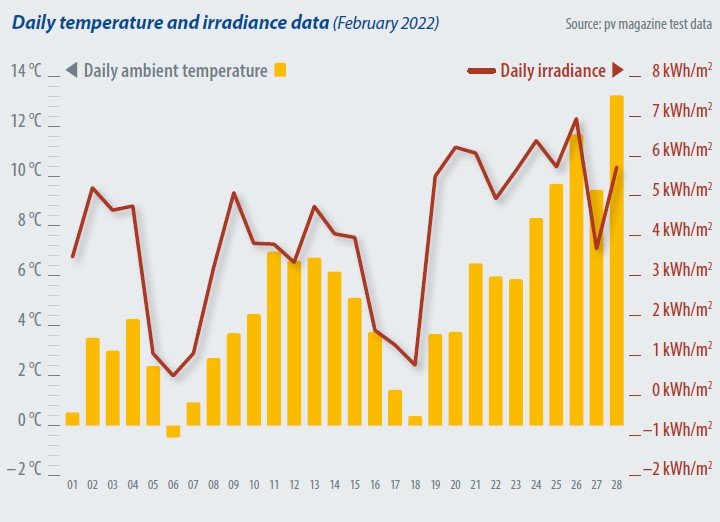pv magazine test: February 2022 Results
By George Touloupas
This article was originally published in pv magazine – April 2022 edition. Learn more about the pv magazine test here.
We are pleased to present the next batch of energy yield results from the outdoor test field in Xi’an, China. In this issue, we present the monthly results for February 2022, alongside additional analysis from George Touloupas, Senior Director of Technology & Quality at CEA.
The first chart below shows the meteo-station data (irradiance and ambient temperature) for February 2022. The average bifacial boost for this period was 5.6%. Bifacial boost is defined as the extra energy yield of the bifacial products compared to the average energy yield of all monofacial mono PERC products.
Figure 1: Daily temperature and irradiance data - February 2022
The following chart shows the comparison between different PV module technologies for February 2022. Bifacial modules are steadily performing above all the other technologies, with multicrystalline modules having the lowest yield. [Read: LCOE of Monofacial vs Bifacial Modules: Are Bifacials Worth the Extra Cost?]
Figure 2: Total energy yield - February 2022
Figure 3: Relative yield of different technologies - February 2022
Notes on the energy yield:
The energy yield comparison among various technologies, including bifacial boost, will be analyzed using products installed after the beginning of 2019.
The energy yield is given in Wh/Wp and is calculated by dividing the energy produced by the module by the Pmax at STC of the module. This Pmax is the maximum STC power after a process of stabilization.
The results are grouped into categories, per module type.
The bifacial boost depends on many parameters: the bifaciality factor, the installation geometry, the albedo of the ground, and the sun angle and diffuse irradiance. The ground in this case is gray gravel.
Table 1: Bifacial boost - Nov 2021 to Feb 2022
Table 2: Energy yield ranking - Nov 2021 to Feb 2022
Test Cooperation
pv magazine test is a cooperative effort involving pv magazine, APsystems, CEA, and Gsolar. All testing procedures are carried out at Gsolar’s test laboratory in Xi’an, China. CEA supervises these tests and designed both the indoor and outdoor testing procedures.















